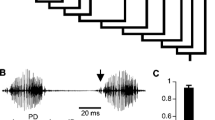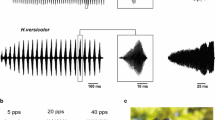Summary
-
1.
In breeding assemblages ofPseudacris streckeri the mating call of one individual often occurs immediately after that of another. Calling by one male then becomes entrained to that of another even though their intrinsic call periods are different. The mechanism underlying entrainment was analysed by presenting acoustic stimuli to isolated males in the laboratory.
-
2.
When trains of acoustic stimuli at various rates were presented, males could entrain to stimuli with periods up to 60 msec (18%) shorter and 50 msec (15%) longer than their intrinsic call periods (Fig. 3). This range of periods corresponds to that found in natural populations (Table 1).
-
3.
Each call-period consisted of three phases: (1) refractory phase—between beginning of period and up to 80 msec before next call; (2) excitatory phase— between end of refractory phase and beginning of call activation phase; (3) call activation phase—last 5–30 msec of call period. An acoustic stimulus presented during the excitatory phase normally evoked a call 30 msec after the end of the stimulus, thus shortening the period by up to 50 msec. Stimuli occurring during the refractory or call activation phases did not evoke calls.
-
4.
Since call periods can be lengthened by up to 50 msec, there must be a lengthened refractory or excitatory phase in the cycle following an acoustic stimulus; this is supported by the fact that the first free-run period following an evoked call is longer than the average call period (Fig. 6). Lengthening probably occurs in the excitatory phase.
-
5.
The call activation phase probably represents neural transmission time between sound arriving at the ear and the resulting evoked call.
-
6.
The acoustic system ofP. streckeri is discussed in terms of a central pacemaker with initiates each call and whose activity is modified in a predictable fashion by appropriate auditory input.
Similar content being viewed by others
References
Brattstrom, B. H., Yarnell, R. M.: Aggressive behavior in two species of leptodactylid frogs. Herpetologica24, 222–228 (1968)
Capranica, R. R.: The evoked vocal response of the bullfrog. Cambridge, Massachusetts: M.I.T. Press 1965
Gerhardt, H. C.: Reproductive interactions betweenHyla crucifer andPseudacris ornata (Anura: Hylidae). Amer. Midl. Natur.89, 81–88 (1973)
Hanson, F. E., Case, J. F., Buck, E., Buck, J.: Synchrony and flash entrainment in a New Guinea firefly. Science174, 161–164 (1971)
Heiligenberg, W.: The effect of stimulus chirps on a cricket's chirping (Acheta domesticus). Z. vergl. Physiol.65, 70–97 (1969)
Jones, M. D. R.: The acoustic behaviour of the bush cricketPholidoptera griseoaptera. 2. Interaction with artificial sound signals. J. exp. Biol.45, 31–44 (1966)
Lemon, R. E.: Vocal communication by the frogEleutherodactylus martinicensis. Canad. J. Zool.49, 211–217 (1971)
Littlejohn, M. J., Martin, A. A.: Acoustic interaction between two species of leptodactylid frogs. Anim. Behav.17, 785–791 (1969)
Loftus-Hills, J. J.: Neural correlates of acoustic behavior in the Australian bullfrogLimnodynastes dorsalis (Anura: Leptodactylidae). Z. vergl. Physiol.74, 140–152 (1971)
Loftus-Hills, J. J.: The neural basis underlying acoustic behavior of the frogPseudophryne semimarmorata (Anura: Leptodactylidae). Anim. Behav.21, 781–787 (1973)
Loftus-Hills, J. J., Littlejohn, M. J.: Mating-call sound intensities of anuran amphibians. J. Acoust. Soc. Amer.49, 1327–1329 (1971)
Schmidt, R. S.: Hearing and responses to calls in anurans. Behaviour23, 280–293 (1964)
Schmidt, R. S.: A model of the central mechanisms of male anuran acoustic behaviour. Behaviour39, 288–317 (1971)
Shaw, K.: An analysis of the phonoresponse of males of the true katydid,Pterophylla camellifolia (Fabricius) (Orthoptera: Tettigoniidae). Behaviour31, 203–260 (1968)
Walker, T. J.: Acoustic synchrony: two mechanisms in the snowy tree cricket. Science166, 891–894 (1969)
Author information
Authors and Affiliations
Additional information
The author acknowledges the support of Dr. W. F. Blair at the University of Texas at Austin and Dr. R. R. Capranica at Cornell University. This work was supported in part by NIH grant NS 09244 to Dr. R. R. Capranica. Mr. R. Sage assisted with recording and collecting in the field. Dr. J. L. Larimer and Mr. J. A. Paton provided assistance and advice during initial phases of the analysis. Drs. R. R. Capranica, F. E. Hanson and M. J. Littlejohn criticized the manuscript.
Rights and permissions
About this article
Cite this article
Loftus-Hills, J.J. Analysis of an acoustic pacemaker in Strecker's chorus frog,Pseudacris streckeri (Anura: Hylidae). J. Comp. Physiol. 90, 75–87 (1974). https://doi.org/10.1007/BF00698369
Received:
Issue Date:
DOI: https://doi.org/10.1007/BF00698369




